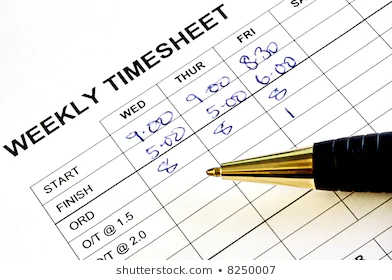
Every large company needs to track its employees’ attendance. Doing so will be efficient for employers in many ways, like distributing payrolls, calculating every employee’s annual leave, establishing regulations and attendance policies, and simply tracking the active hours of every employee and keeping the company’s data up-to-date.
Although it may not sound like a problem, because it’s a simple task that can be done by anyone, any employer will soon figure out the necessity of keeping track of every employee’s attendance. A Timesheet is a simple and modern way to achieve this and every employer should keep it in mind! If you are new to timesheets, here is some information on what they are and why they’re important
What Is a Timesheet
As the name suggests, timesheets are tables that track the working hours of all your employees. This way you will know who is there and who isn’t, how long it took your employees to work on a certain project, and overtime costs. Not too long ago, older variants of timesheets existed, like punch cards and time cards. Nowadays, people use better, more refined versions of these timesheets and they are more accurate in terms of keeping the database of the company as up-to-date as possible. They also help companies with understanding payroll costs.
Timesheets are popular, easy to use, versatile, and won’t leave room for mistakes. This is why so many companies prefer to use them rather than using other methods. They will easily fit into the nature of your company, as they’re relatively adjustable, and no one will have a problem using them so they are always the safe way to go. That is why you might be in need of neat and flexible timesheet templates. Experts at ExcelTemplate.net provide full information on timesheet templates and why they are important for your business. They also recommend the best practices to follow when you use a designed timesheet, so it would perfectly suit your business and employees.

Why Do You Need a Timesheet?
There are a couple of reasons why you might be obliged to use timesheets in your company if you haven’t done so already. Aside from what is mentioned before, there are other reasons why integrating timesheets into the daily tasks of your employees is important:
-
Minimize Costs
If you implement using timesheets, you will observe a change in your company’s costs, because if your employees are doing what is called ‘buddy punching’, then your costs are likely to be larger than they should be. Attendance tracking will help minimize these costs and will make distribution of payrolls fair. If you are giving payrolls according to the scheduled time and not the actual time an employee has spent on a certain day, you will be paying more than you should be, and the effort and projects done won’t match with what you are paying your employees. After all, every dollar counts. So, consider having your employees use a timesheet to avoid attendance fraud.
-
Keep Your Employees’ Spirits High
If your employees stick to their schedules, then they will get paid accordingly. So, when you have them use timesheets, chances are they will be more productive. Checking their time-ins and time-outs will give them the opportunity to prove their worthiness, they will be more willing and enthusiastic about getting to work on time, and even make their own individual contributions in order to be rewarded. They will also be more willing and efficient in finishing projects in an ideal time to get bonuses. The constant influence of timesheets will create a change in the work dynamics, as opposed to a company that doesn’t use one at all.
-
Important Statistics
Using Timesheets will also provide you with information and numbers regarding what your company might need for the foreseeable future. For example, if everyone is sticking to their schedules and finishing their projects on time, and the numbers still don’t add up, then you will know at this point that you need to hire more people, or you might need to adjust workload to fit the schedules of your existing employees if it isn’t already adjusted. Also, if you are having a problem in making important decisions for your company, tracking the attendance of your employees will make this process go faster.
The hassle of every workday can be avoided with timesheets. It will not only keep everything in check, but it will also bring you solutions and help your company in terms of managerial decisions. So, make sure to use one that includes the necessary information you need to manage your employees more effectively and ensure that compliance with all regulations, schedules, and deadlines.









Good article, but I really don’t agree with using a spreadsheet for time tracking. I did just that at my last job, and it was a total waste of time for everyone involved. It’s cumbersome, and it gets annoying to store all of those spreadsheets securely after a while. It was literally just a place to put # of hours worked every day, and without context, that really didn’t mean much. At my current job, we use an actual time tracking software (BeeBole) that allows for a deeper understanding of hours worked (ie, running reports to look at ROI, budgets and more) and that automatically and securely saves data to the cloud. I think that’s the smarter way to go here.